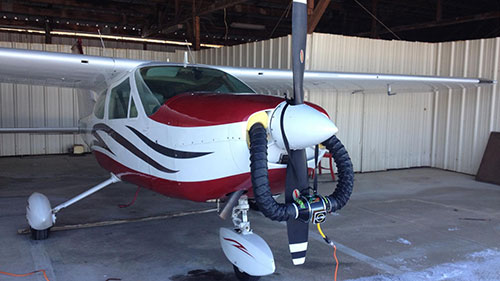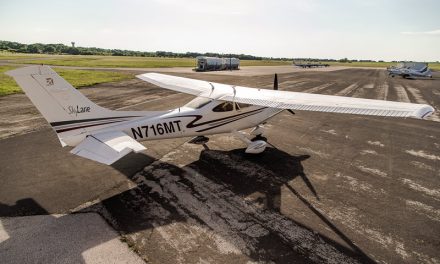AVIATION EDUCATION
Say “No” to Airspace Anxiety
By Scott Stahl
Every year thousands of pilots descend on the biggest spectacle in aviation, AirVenture in Oshkosh, Wisconsin. For many would-be attendees the thought of flying in such busy airspace is a daunting one. However, with proper planning and by using techniques that apply to busy airports in general, flying into Oshkosh can be a fun experience for a pilot of any skill level and should be on the to-do list of any pilot interested in going to the show.
There are several actions pilots can take to make operations in busy airspace less stressful and safer for everyone involved. Thorough consideration of these elements will make any flight into crowded airspace a more enjoyable experience and less an exercise in frustration.
Pre-flight Reconnaissance
A thorough pre-flight planning process is the first thing that should be done by any pilot wishing to enter busy airspace. Most busy airports have procedures that are specific to that airport. Such procedures include precise arrival and departure procedures, noise abatement procedures, and special considerations when transiting to or from the airport where traffic in the vicinity may be very active. A pilot should begin the planning phase to any airport (especially busy ones) with a review of these procedures.
The first resource to check is the Airport Facilities Directory (free download available at www.faa.gov). The directory provides the pilot with a fundamental understanding of special traffic procedures including which frequencies need to be used, basic noise abatement restrictions, and any warnings that may be of consequence when operating into or out of the airport. In some cases, the noise abatement procedures can be obtained by calling a phone number where briefings are provided by airport operations. The directory may also offer information about available fuel services, hours of operation, and other useful details.
Prior to leaving for any airport, the pilot should also review any Notices to Airmen (NOTAMs) that apply to that particular airport or route. Nothing generates a surprise like arriving at a destination and realizing that the runway is closed for construction! The NOTAMS may also include other important information about TFRs, obstructions, or other operational considerations. Knowing such things ahead of time will always streamline the arrival and departure processes and improve coordination with ATC.
A good pre-flight will also include a check to make sure all publications are current and complete. Current departure, en-route, and arrival charts should be a standard part of any flight bag. At many busy airports, it’s understood that the pilot will have current charts. If they aren’t available or current, it’s reasonable to expect frustration on the part of the controller as well as a detailed verbal description of the procedure. At many airports, departures and arrivals are a standard part of the operation and some will even have VFR procedures in effect to aid traffic flow. Having current charts at the ready will also provide a quick reference should the anticipated flight plan change, which is often the case in busy airspace.
In some cases, if the airport is busy due to certain large operators (flight schools for example), it’s prudent to contact them to gain some insight into local operating procedures, practice areas, local frequencies, departure/arrival routes, etc.
Extra En-route Attentiveness
Once underway, here are some tips that will help to ease the transition into busy airspace.
1 Maintain traffic vigilance
While it’s always incumbent upon the pilot to avoid traffic, this becomes especially crucial during operations around busy airports because the statistical likelihood of encountering another aircraft increases tremendously. It may be helpful to monitor local frequencies (like those used for local practice areas) in order to gain an increased awareness of what’s in the sky around you.
2 Start the arrival process early
Taking a cue from IFR flying during this phase might be helpful. Make sure all appropriate descent/in range checklists are completed well in advance so that more attention can be paid to traffic avoidance, situational awareness, and understanding and complying with ATC instructions. Brief the most likely route of arrival based on current position, ATIS information, and current traffic flows. This will increase the likelihood of entering the flow of traffic in a uniform fashion rather than disturbing it and increasing the likelihood of confusion or conflict.
3 Build situational awareness
When ready to contact ATC, make sure to spend a few minutes monitoring the frequency. It’s also a good idea to be prepared to contact ATC well in advance. Even when still outside of the controlled airspace, it gives ATC an idea of what’s coming, so they can plan for the sequence of arrivals. It also informs any other aircraft on frequency of other traffic location sand intentions. For most Class D airports, 10NM is a good rule of thumb for when to make initial contact. Usually, ATC will issue instructions on where to proceed for arrival, or what to expect on arrival. In many cases, they’ll also provide at least some guidance on the location of conflicting traffic.
However, it’s important to understand that with the exception of Class B airspace, the pilot is always primarily responsible for collision avoidance and traffic advisories are a courtesy provided by the controller on a “workload permitting” basis. In Class D airport areas, the controllers are only legally obligated to provide traffic sequencing in the immediate vicinity of the runway and may not provide any traffic information, although at any airport traffic advisories are on a workload permitting basis. Even in higher classes of airspace, it should not be assumed that all traffic will be issued. This is why it’s so important to build an awareness of what’s happening in the area. If traffic calls are issued, they should be acknowledged with the call sign of the responding aircraft and either a “traffic in sight” or “negative contact” response.
Avid Arrival & Departure Awareness
Once on the ground, it’s important to understand some specific guidelines that are likely to be encountered, the first of which are taxi instructions. Large, unfamiliar airports can be very intimidating, especially if there are multiple runways in use, crossing runways, or complex taxiway layouts. In such cases, it’s best to have a current airport diagram. It’s also advisable to request step-by-step direction (aka“progressive taxi”) to the destination.If operating without progressive taxi instructions, pay close attention to runway signs and markings. Many runway incursions are caused by inattentive pilots accidentally crossing a hold short line. If unsure about crossing something,be sure to ask.
A common area of confusion is the read back of runway assignments and hold short instructions. It’s mandatory that when issued any hold short or runway assignment in a taxi clearance that the runway assignment and the hold short instructions are read back with the aircraft call sign. If the controller doesn’t hear those two parts in the communication, they must re-issue the instruction until both components are read back correctly with the call sign. Similarly, when there are multiple parallel runways, it’s required that the full designation be read back. For example, “runway 21 Left” is not the same as just saying “runway 21.” Rule of thumb: if the controller reads a runway assignment,the pilot should include it in the read back exactly as the controller issued it.
A procedure frequently used at high volume airports that isn’t as common at non-towered fields, is the “line up and wait” instruction. Issued by the controller, this clearance allows an airplane holding short and ready to takeoff to proceed onto the runway, but not actually take off. Usually, this procedure is used to minimize the delay between arrivals and departures. When issued a line up and wait clearance, there are two essential considerations: first, maintain a sterile cockpit and listen closely to all radio chatter—takeoff clearance will be imminent; second, pay attention to any traffic calls for the traffic pattern leading to the runway. It’s unfortunate that airplanes have been holding short on the runway while other airplanes were cleared to land on top of them! Current ATC procedures require controllers to advise the aircraft holding in position of the next landing aircraft’s location, as well as advising the next aircraft in sequence that there is an airplane positioned on the runway. That holds true even if the next landing aircraft is on upwind for the current runway.
Conquering a congested airport can be an exhilarating, worthwhile experience and a real confidence booster for any pilot. However, while the possibilities for new experiences are endless, scrupulous planning, preparation, and communication are imperative. If you’re making your way to Oshkosh, have a memorable and safe experience. I hope to see you there!






